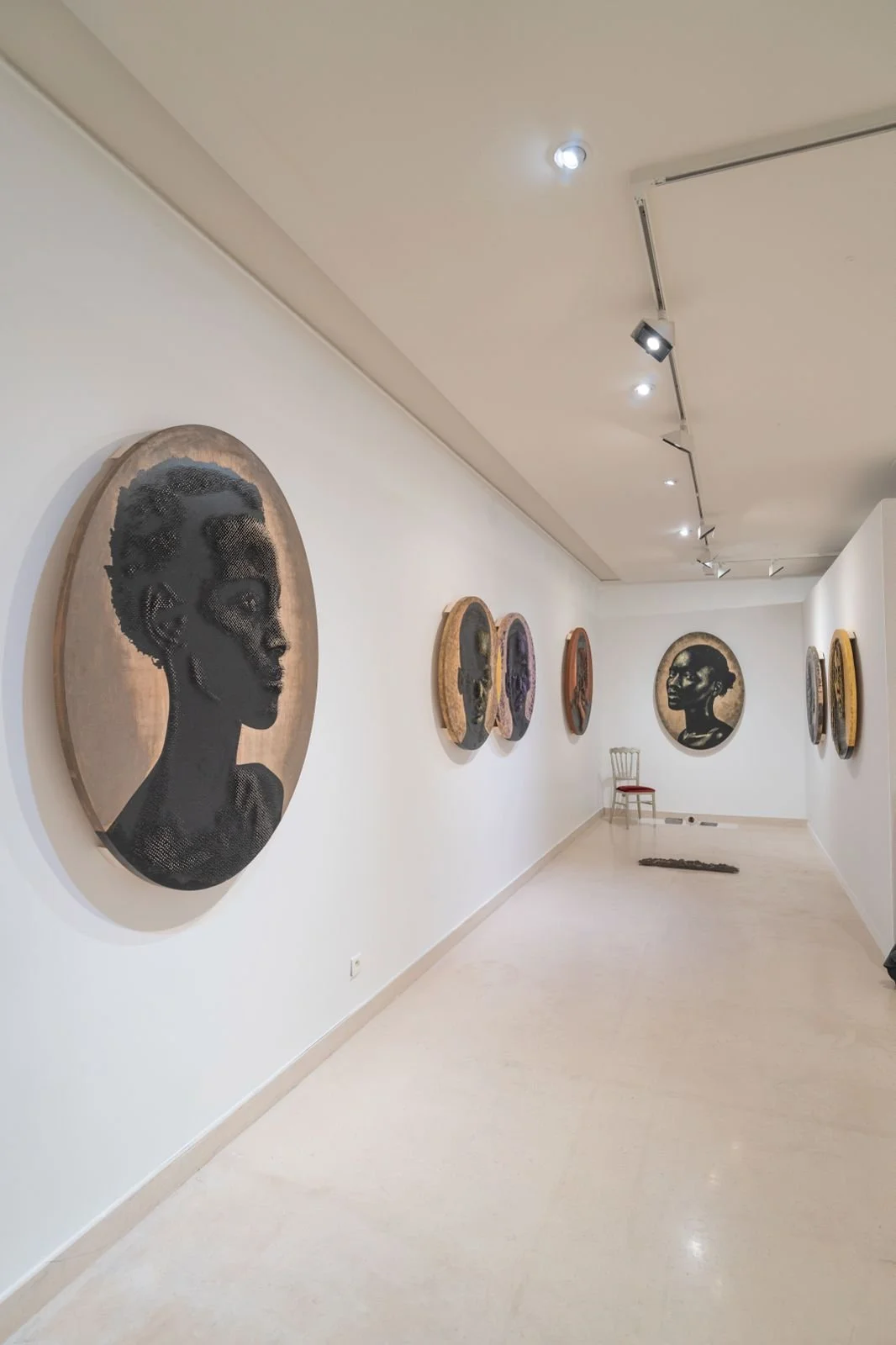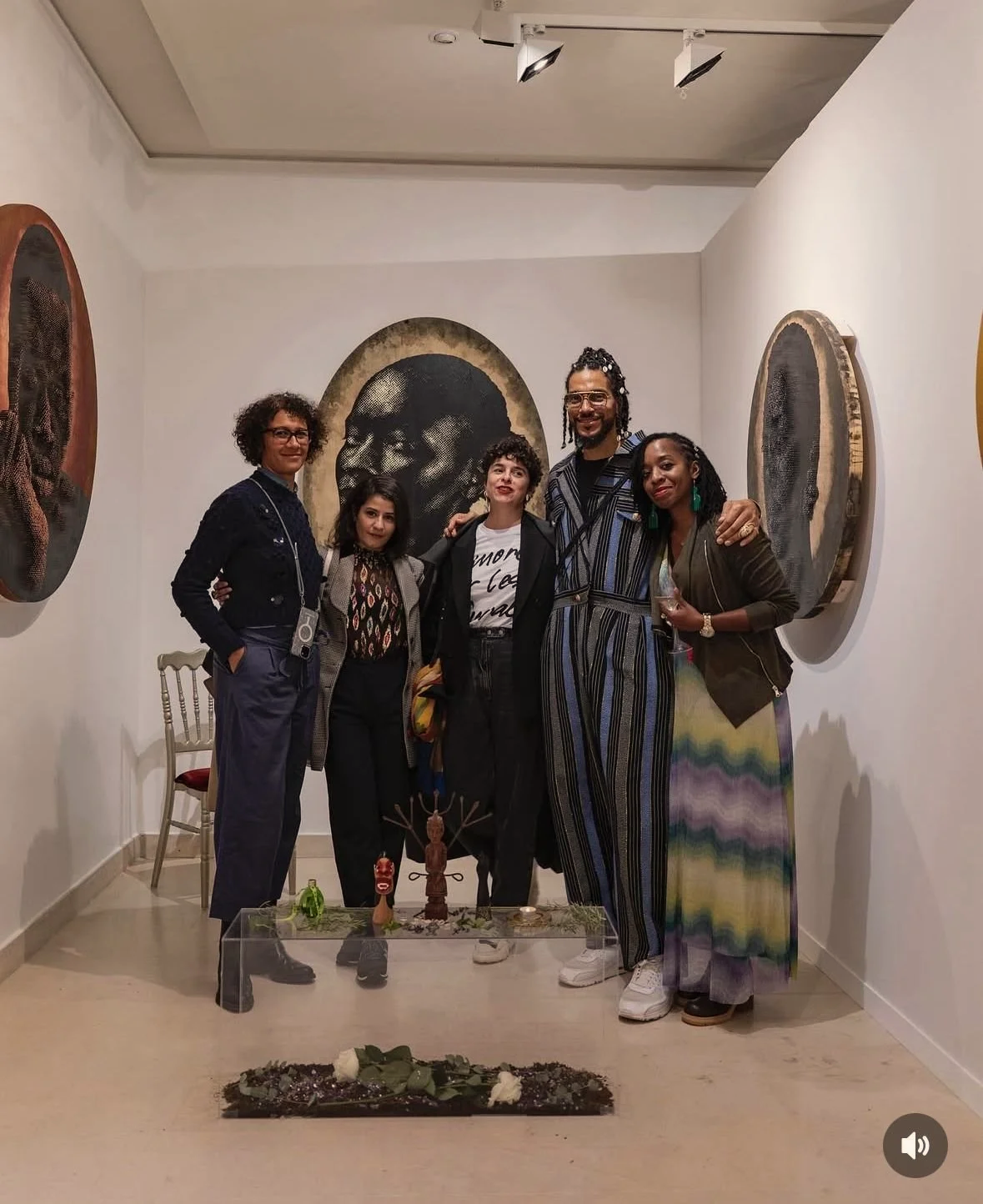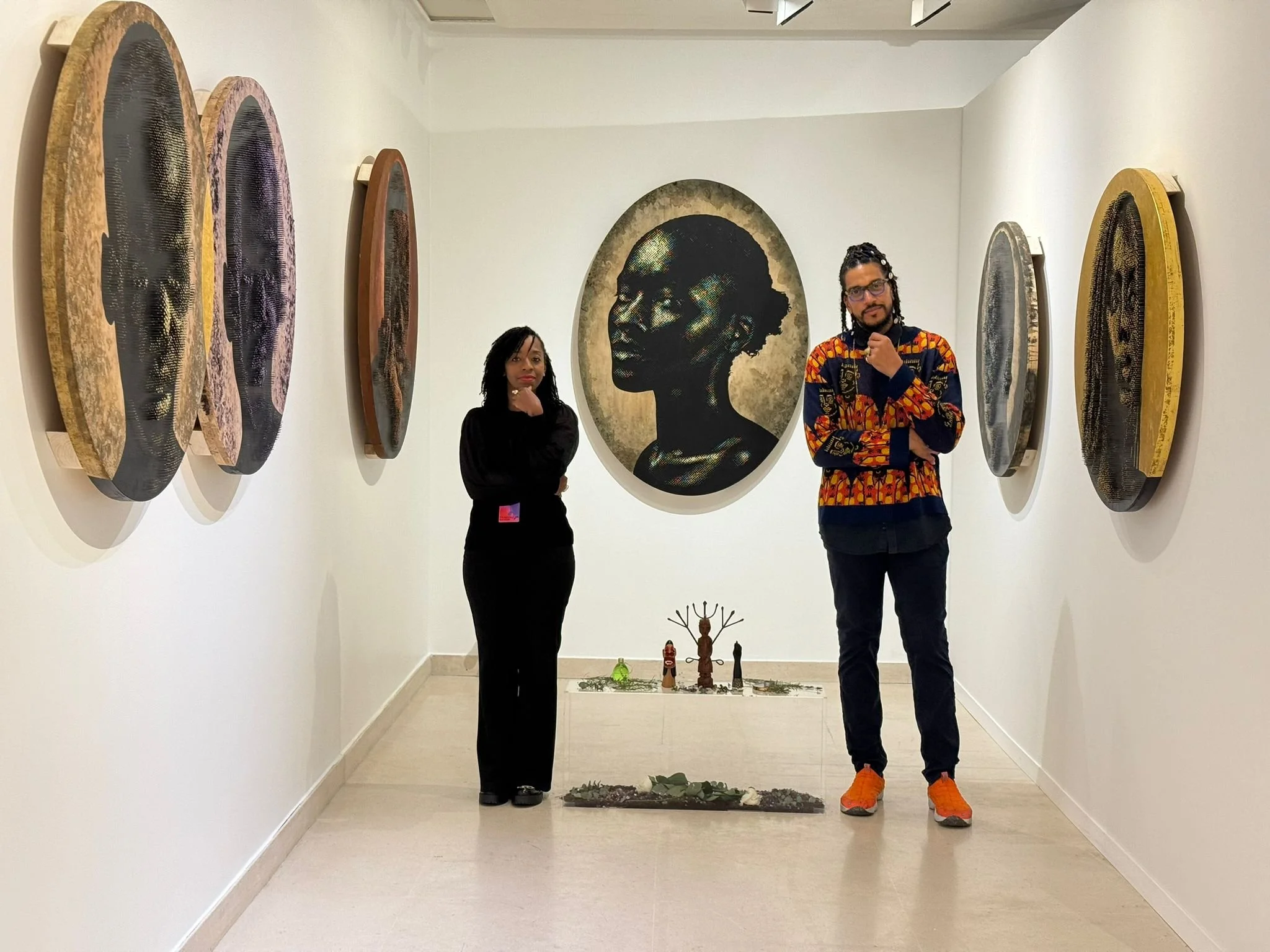Alexis Peskine presents ‘Ouro Verde’, the story of a rebirth
This is the story of a death - or rather, a rebirth. Alexis Peskine presents Ouro Verde at the MIRA fair with Filafriques, a new collection rooted in a profoundly transformative episode of his life and in a spiritual awakening closely tied to his Afro-Brazilian origins. Initiated into Candomblé, a tradition deeply anchored in Brazil, the artist marks a rupture in his practice. He recounts this foundational experience — both intimate and artistic — while reflecting on his journey, navigating between identity expression and a renewed sense of activism.
Alexis Peskine during MIRA Art Fair, November 2025
During the second edition of MIRA Art Fair, we had the opportunity to meet with Alexis Peskine, who unveiled Ouro Verde — “Green Gold” — a new collection that, while continuing his artistic trajectory, marks a distinct rupture. Between healing, knowledge, and community, Alexis Peskine reveals the secrets behind Ouro Verde.
Ngalula MAFWATA, MAYÌ-ARTS: What is the meaning of Ouro Verde ?
Alexis PESKINE : Ouro Verde means “Green Gold” in Portuguese, draws its inspiration from the practice of Candomblé spirituality, into which I was initiated. Ouro Verde holds a powerful symbolism for me, capturing a particular episode in my life: a traumatic experience that left me in a prolonged coma for several days. Following this experience, I felt the need for peace and a spiritual return. I already had a spiritual connection, notably through cowries, which I have been connected to for around fifteen years now. But it was through contact with healers, similar to babalawos, who guided me and initiated me into leaf baths and a range of practices, that this bond deepened. This is what lies behind the concept of Ouro Verde.
Ngalula MAFWATA : What are the formative experiences behind this new collection?
Alexis PESKINE : When I introduce a new exhibition, I like to understand the history of the spaces involved. This collection was built around the locations where I grounded myself throughout its creation. All the models are Afro-Swiss. During the creative process, we focused particularly on indigenous Swiss healers with ancestral knowledge, especially regarding plants. I also recall conversations with a Rwandan-Swiss friend of my brother, who is also a healer, as well as a documentary by RTS showing the limits of so-called modern medicine in serious cases of eczema and terminal cancers, which were ultimately cured by traditional medicine. Miraculous healings for which Western science and healthcare professionals have no real explanation. These examples highlight the Western tendency to want to explain everything and disqualify what cannot be explained.
Ouro Verde #1, Ilona Alexis PESKINE 2025, Filafriques
“This collection was built around the locations where I grounded myself throughout its creation. All the models are Afro-Swiss. During the creative process, we focused particularly on indigenous Swiss healers with ancestral knowledge, especially regarding plants. ”
Ngalula MAFWATA : It is very interesting to see how you have managed to intersect your personal journey with your current physical geography while continuing to nurture your spiritual quest…
Alexis PESKINE : Looking back, I think, we have been guided by our ancestors, the orixás, and elements from the unseen of the all along the journey. As I was in Switzerland, we did an extensive work of research and documentation with Carine (Carine Biley, Filafriques).
Everything aligned divinely and came to us with a certain ease. Of course, we made the effort to first seek, however things presented themselves to us almost as offerings. For example, we found the farm of Mamajah where the plants, flowers, and petals were given to us. In her generosity, she provided everything we needed. Our research also led us to different places: we went to Lake Geneva were Carine took us to extract powder, a friend brought me soil from the Congo to pigment a piece we presented, and I also collected mud from the mangroves in Guadeloupe. It was important to gather all these natural elements to complement what I was already using: European plants such as rosemary, eucalyptus, mint, basil, and lavender.
Ngalula MAFWATA : There’s a kind of personal reflection in this work. What has changed for you?
Alexis PESKINE : Yes, there is a form of parallel between my need for inner serenity and healing. I have long expressed my resistance through my work. In my family, activism is a legacy, and for a long time I have focused on issues related to racial oppression in the Western world. Over the years, however, my perspective has shifted. When we are young, we have passion and hope; but as you grow older, you tend to realise how things don’t really change. We live in an increasingly capitalist and violent world, even if we try to hide that reality. Today, these dynamics are more visible than ever, both fortunately and unfortunately - which can sometimes be depressing.
Nowadays, I tell myself that it is time to take care of myself: my inner world, my mental health, and my well-being. Things won’t stop, but at some point, the revolution also needs to happen within. It is essential to go through that process: pause, reconnect with oneself, and then return to the fight if you wish. Resistance requires immense mental strength. And the mind, like the body, needs maintenance.
Ouro Verde, Alexis Peskine
Alexis Peskine during MIRA Art Fair, November 2025
Ngalula MAFWATA : How would you describe the evolution of your practice over the past few years? Do you feel your way of working has changed?
Alexis PESKINE : It is quite subtle. I was already using and incorporating earth and certain colors into my work; what has truly changed, however, is the intention. The intention behind the work. Last year, for example, my pieces began to take on organic shapes, closer to those of plants. I became more deliberate with my choice of colors and materials. It’s subtle, but intention transforms the spirit of the work.
Ngalula MAFWATA : And what does this central altar signify?
Alexis PESKINE : This altar represents what I do at home. I place elements there that I use daily, such as flowers. It was important for me to recreate the altar I have at home, at the foot of which I meditate and express my gratitude each day. With my orixás, it was also essential to represent them and give thanks.
“In the contemporary history, exhibitions like Les Magiciens de la Terre (Jean-Hubert Martin, 1989) or Africa Remix (Simon Njami, 2004) marked a shift. It was from that point that attention and visibility began to be given to Afro-descendant and Caribbean artists, where African diaspora artists used to received only moderate visibility. ”
Ngalula MAFWATA : Identity is a central thread in your work. How do you anchor it today ?
Alexis PESKINE : The most recent series of my work is called Forest Figures. They follow the Power Figures, which embodied protection, and the Fire Figures, which embodied revolt. The Forest Figures represent healing, serenity, well-being, love, and nature. I’ve noticed that resistance has often been framed in response to white supremacy. However, it’s important simply to live. It’s important to be ourselves outside of reaction, to embody what life could be like without oppression. It’s essential to engage in our practices and rituals, to create and love as we wish, to create as we want, without being caught in reaction, oppression, or the oppressor.
Ouro Verde #12, Ère Ibeji, Alexis PESKINE 2025, Filafriques
Ngalula MAFWATA : This seems to be a reflection that’s quite present within the Francophone world, doesn’t it ?
Alexis PESKINE : Not exclusively. Americans share this perspective as well. However, I have noticed that many Francophone people of African descents for the most part tend to make a distinction between the Francophone world and the Anglophone world, where those we call Anglophones, for example, never define themselves that way : they identify simply by their country of origin. Take Nigerians, Ghanaians, or South Africans, for example.
This issue brings us back to what I mentioned earlier: the idea of existing outside the gaze of the former colonizer. Our worlds are sophisticated, complex, incredible. And paradoxically, we contribute to creating the coloniser’s world, a world that does not exist without us and that, in a sense, only matters because we are part of it. Collectively, we have stories, universes, and cultures rich enough to exist without having to define ourselves through a past—and even present—colonialism.
Francophone colonialism, however is insidious as it infiltrates intimacy. It monitors and seeks to integrate the former oppressed into a particular way of thinking as destructive this can be. It ensures that the former colonised remain aligned with the narrative but without any real compensation. Deconstructing this narrative is an immense challenge. It is a system that has saved many countries from conflicts and crisis and helped rebuilding and creating wealth — economically, technologically, intellectually, culturally. And the moment you detach from it, it tries to pull you back in.
We see this today in the evolving France–Africa dynamics, with strategies of seduction, particularly in the cultural sphere. This is a new form of soft power. In societies where the cultural fabric has been deeply damaged, it becomes extremely difficult for artists to access scenes or platforms that are not dependent on these France–Africa dynamics or major oligarchies. It is still rare for an African artist to present their work on the continent without going through large conglomerates.
“In societies where cultural fabric has been deeply damaged, it becomes extremely difficult for artists to access scenes or platforms that are not dependent on these France–Africa dynamics or major oligarchies. It is still rare for an African artist to present their work on the continent without going through large conglomerates.”
Ngalula MAFWATA : Has it been easier for you to enter the art market outside of France ?
Alexis PESKINE : As a French-born African descent, I haven’t exhibited much in France until recently. I first presented my work in the United States, with an initial exhibition titled The French Revolution in Brooklyn, and I exhibited there extensively before returning to Europe. In the contemporary history, exhibitions like Les Magiciens de la Terre (Jean-Hubert Martin, 1989) or Africa Remix (Simon Njami, 2004) marked a shift. It was from that point that attention and visibility began to be given to Afro-descendant and Caribbean artists, where African diaspora artists used to received only moderate visibility. It took a certain time for exhibitions dedicated to Africa to also open up to diaspora voices.
For my part, I didn’t fit neatly into any of these categories: not “Brazilian enough” from the perspective of my upbringing in France, even though I grew up in a culturally rich family; not French enough either. In my personal journey, I began traveling frequently to Africa, particularly Dakar, from 2010 onward, participating in biennales, and I gradually became integrated into this Pan-African cultural movement.
Carine BILEY (Filafriques) and Alexis PESKINE during MIRA Art Fair, November 2025
Ngalula MAFWATA: Ultimately, what should we take away from Ouro Verde?
Alexis PESKINE: We need to take care of ourselves. To support one another and look after each other. Healing in community is essential, because we live in a world that pushes us toward isolation in order to better control us. We must travel, grow, and above all, learn. Love, love others… the ones who are lovable! (laughs)
Explore Alexis Peskine’s Ouro Verde on Filafriques, along with his personal spaces.







